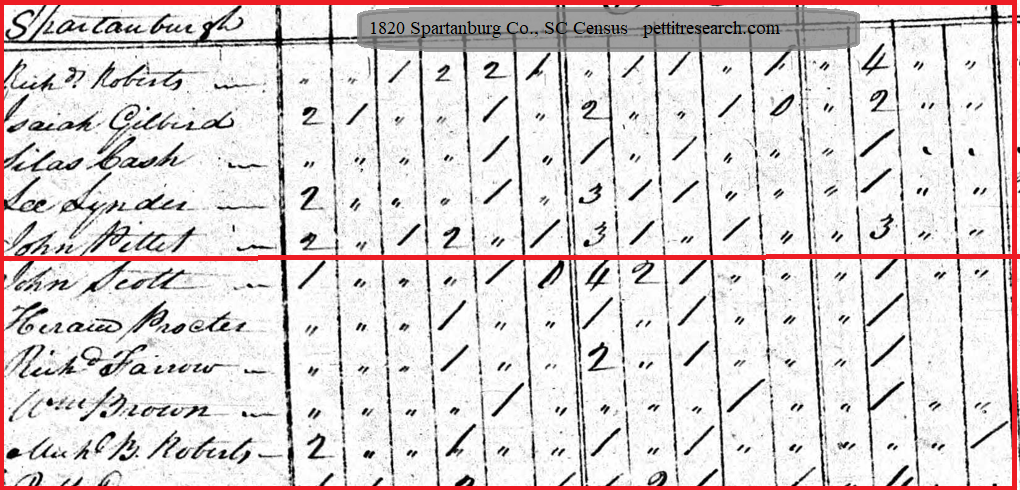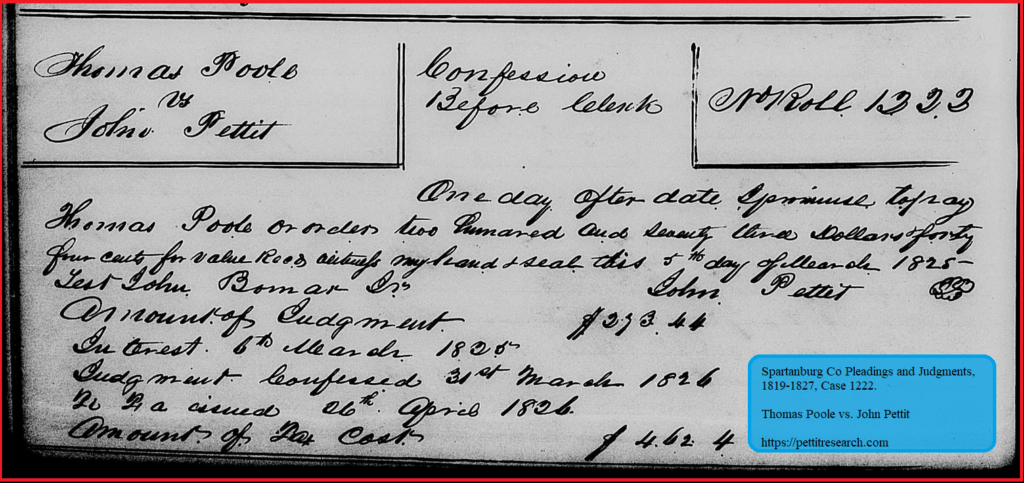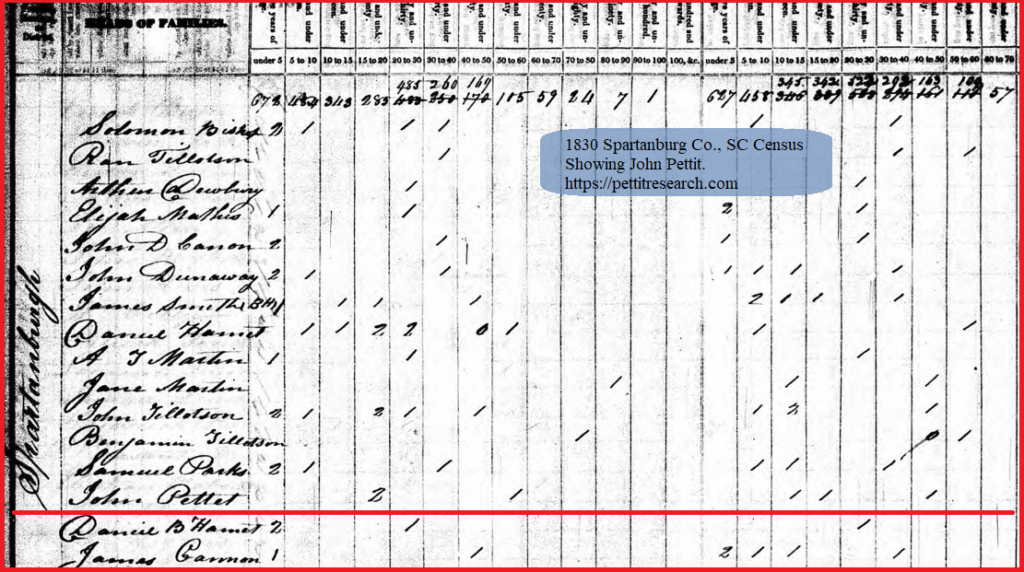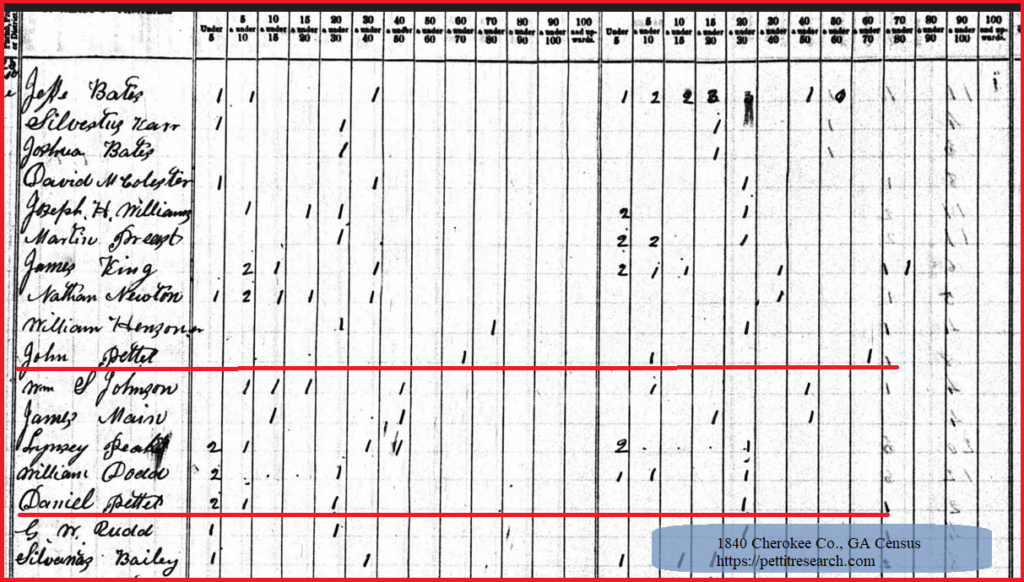John Pettit (b. 1771) Son of Joshua and Rachel Pettit of Spartanburg Co., SC

“John But Not Forgotten” John Pettit Born 1771, Son of Joshua and Rachel Pettit of Spartanburg Co, SC
This article will broadly cover the life of John Pettit the son of Joshua and Rachel Pettit of Spartanburg Co., SC who was born on September 2, 1771. Sadly, his existence has somehow gone unnoticed for many years by many Pettit family researchers. John Pettit born in 1771 was likely the father of at least 5 sons and 4 daughters but his children, in most cases, have been incorrectly assigned to either his brother Joshua Pettit Jr. (d.1827) or Benjamin Pettit (b.1769). Consequently, entire branches including many of his living descendants today are erroneously connected to the wrong ancestor. For example, some decedents of Nathaniel H. Pettit incorrectly and steadfastly believe he was the son of Joshua Pettit Jr. (That notion is dispelled in this article.) In this writing we will attempt to put John Pettit back in his rightful place on the family tree and award him the children he likely fathered. Those that are believed to be his children are as follows:
- Elijah b.~1795
- Solomon b.~1796
- Benjamin b.1804
- Ruth b.1807
- Daniel b.1812
- Nathaniel H. b.1813
John Pettit Birth and Birthplace
John was born on September 2, 1771, to Joshua and Rachel Pettit. His birth is recorded in the family Bible of his older brother, Henry Pettit Sr. (More information on this Bible record can be found in this article.) A cleaned-up excerpt of that Bible record can be seen below.
His birthplace was likely either South Carolina or Virginia. On March 14, 1770, his father Joshua Pettit was at the Steenbrgen Ordinary in Romney, Virginia. On December 21, 1773, Joshua witnessed a land transaction between the Cherokee head men and a trader named Richard Pearis in what would later become Greenville County, SC. John was born in between these two dates but there is no record in this 3-year span to indicate when the Pettits moved from Virginia to South Carolina. There is some scant evidence the location of his birth may have been South Carolina.
Daniel Pettit, a man who is thought to have been his son (discussed more below), was recorded on the 1880 census in Polk Co., GA. The census taker recorded the birthplace of Daniel’s father (and mother) was South Carolina. Assuming this is accurate and assuming his father was indeed John, then John was born in South Carolina.

1880 Polk Co., GA Census showing Daniel and Lovina Pettit. Daniel is believed to have been the son of John Pettit (b.1771). If this census record is accurate this would mean John was born in South Carolina.
Childhood in the Revolutionary War Years
By September 12, 1775, little John and his family were living in South Carolina. John’s younger brother Nathan Pettit was born in South Carolina on this date. His date of birth is recorded in the family Bible as well and his place of birth is noted on several censuses.
Sometime that year, old Joshua Pettit sold off a 500 acre tract of land he had acquired from the Richard Pearis/Cherokee land deal to John Armstrong from Frederick Co., VA. It is not known if the Pettits ever resided on this land, but in 1776 they settled in on on Lawsons Fork of the Pacolet River in 96 District, South Carolina. This was according to the Revolutionary War account of Henry Pettit Sr.
In July of 1776 the Cherokee massacred many of the families who lived west of the Indian Boundary. This was very close to home for the Pettit family. In response, John’s father Joshua was called up to help build a fort known as Wofford’s Fort commanded by Col. William Wofford. This fort would prove to be a valuable place of refuge for the back country families in the case of Cherokee or Tory attacks. While his father Joshua Pettit was working with Col. Wofford to construct the fort, his brother Henry Pettit volunteered to serve as a substitute in some early South Carolina campaigns of Revolutionary War. John Pettit would have been just 4 years old when he watched his father and brother ride off to war in July of 1776. Over the next year, young John may have spent many a restless day under the watchful eye of his mother in this fort which had been built by his father’s hands.
Just a few months later, on October 29, 1776, Rachel would give birth to John’s brother Abraham Pettit. His mother had her hands full. Abraham suffered from some sort of mental or physical ailment which caused him to need a caretaker into his adulthood. Thankfully, by the end of 1776 the Cherokee warriors had been subdued and fighting had tapered off in the south in general. Joshua and Henry soon returned home.
On April 9, 1779, a younger sister was born to Joshua and Rachel Pettit who they named Rachel. This was the last recorded birth in this family. At the Pettit home to welcome her would have been her parents, Joshua and Rachel Pettit and siblings: Henry 16 y/o, Joshua ~14 y/o, Hannah ~14 y/o, Benjamin 9 y/o, John 7 y/o, Nathan 3 y/o, and Abraham 3 y/o. (estimated ages best on current evidence)
On May 12, 1780, the British captured Charleston and the war made a violent return to the Carolina back country. John’s father Joshua and brother Henry again enlisted to aid the Patriot cause. This time they served under the command of Col. Benjamin Roebuck. Records indicate their service was “before and since the fall of Charleston.” Violent men like Banastre Tarleton and William “Bloody Bill” Cunningham murdered their way across the countryside and found several innocent victims around the Pacolet River settlement. Houses and fields were burned. Patriots were drug out of their homes and shot in front of their families. John Nucklos, for instance, on December 11, 1780, was murdered by Tories and his body stuffed into a hollow tree while he was on his way to a mill. He was a neighbor who lived nearby at Thickety Creek and Joshua Pettit had witnessed a land transaction involving him. Aside from the bloody scouting of Cunningham, numerous engagements and battles took place in the vicinity of Lawsons Fork. It would not have been unusual for the residents to hear distant gunfire as they worked in the fields. These must have been terrifying times for the Pettit family.
On January 17, 1781, Henry Pettit and presumably his father, were at the battle of Cowpens. This monumental battle was only about 10 miles from where the Pettits probably resided. At this battle, John’s brother Henry was wounded in his thigh and returned home to recover. He would reenlist again in April. The record is not clear, but it seems that something may have happened to John’s father Joshua Pettit in or around the year 1782.
John Pettit would have been about 10 years old in 1782 when when Henry showed up with his fellow troops under the command of General Pickens. The soldiers were in need of of some beef and fodder and the Pettit family supplied it to them.
In November of 1782 a war treaty was signed and the British were driven off the continent. Some semblance of peace returned to 96 District. John would have been 15 years old when, on September 15, 1786, his father was confirmed to be deceased in an audited Revolutionary War account. His demise may have been some time earlier than this but the impact on young John would have been the same.
Teenage Years and A New Family
If John’s father Joshua died between 1780-1786, and his mother was still alive, there would have been several small children for her to take care of in addition to the cattle and crops. We can only speculate, but it is possible the family may have been divided to ensure their survival. Mother Rachel and the younger children may have moved in with another family, perhaps the family of Joel Hembree and his (presumed) wife Hannah Pettit. The teen boys, on the other hand, could have been apprenticed out or worked as farm laborers nearby for room and board. At censustime in 1790 John would have been 19 years old and his brother Benjamin would have been 21. They were old enough to head their own households but it does not appear that they did. The only Pettits who materialized by name in the 1790 Spartanburg County census were brothers Henry and Joshua Jr. Based on the data and the known birth dates of their children, it does not seem that John, or any other sibling, was living in Henry or Joshua Jr’s household. John’s whereabouts during this time simply is not known.
Sometime between 1790 and 1795 John would find a bride slightly younger than he. Evidence indicates they made their home near Peter’s Creek of the Pacolet River. There is nothing in the record that suggests he purchased land here until some time later. He perhaps was a tenant farmer living on someone else’s spread.
Before 1800 three sons were born. These were most likely an Elijah, a Solomon, and a Benjamin. John, the family man, made his first census appearance in 1800 in Spartanburg County. In his house was (1) Male age 26-44, (1) Female age 16-25, and (3) Males under age 10.
Neighbors include Abbott, McAbee, Ward, Wyatt — all landowners in the Peters Creek/Pacolet area.
In March of 1801 John witnessed a deed for the sale of 150 acres of his brother Henry Pettit’s land to his brother Joshua Pettit. In April of 1802 he appeared before Spartanburg County Justice of the Peace, John Lipscomb, and made oath he witnessed the 1801 deed between his brothers. (Spartanburg Deeds, Book F, p 219)
He would have been well familiar with John Lipscomb who was the secretary for Goucher Baptist Church. Sometime around this time period he began attending Goucher Baptist Church where his brothers Henry and Joshua Pettit Jr were also members. Goucher Baptist Church was on the other side of the Pacolet a good 15 miles or more from the Peters Creek community. Attending the church meetings would require a fair trip on horseback from John’s home. The minutes indicate John was in regular attendance and made financial contributions to support the church as well.
It should be mentioned that a preserved minute book from Goucher Baptist Church contains a fragment of what looks like an early membership roll which has fueled speculation that John’s wife may have been named Nancy. At the time, none of the children of Joshua and Rachel Pettit nor their grandchildren would have been named Nancy. Nevertheless, member number 30 on the list was a woman named Nancy Pettit.
Nancy is a common nickname for Anne. As early as 1812, Henry Pettit and his wife Ann Poole Pettit were very involved in this church. Ann appears in the minutes in conjunction with her husband Henry but it is always by the name “Ann Pettit”. The early Nancy Pettit could have been John’s wife, or she could have been Henry’s wife Ann. She could have also been someone else. There is not sufficient information to reach any conclusion at this time. This fragment is from the first page of the minuet book which is said to have begun in 1810 but no context as to its meaning is provided.
John was again in Spartanburg County in the same Peter’s Creek neighborhood when the next census was taken in 1810.
John’s family had expanded to include a total of 4 male children and 2 little girls. His neighbors included Robert Armour, many Cannons, McAbees, Wards, and Wyatt –all landowners in the Peters Creek/Pacolet River area.
Farm Life on Peters Creek, Spartanburg County, SC
On January 7, 1815, John Pettit bought 222 acres “on waters of Peters Creek” from Robert Armour. The deed was witnessed by Enoch Ward and Sampson Sosebee. There is no record of land ownership for John Pettit prior to this transaction though he clearly lived in the area.
The following year, John was selected to deliver a letter from Goucher Baptist Church to a sister church on the other side of the river called Buck Creek Baptist Church. The minutes note that the message was delivered by John to Bucks Creek Baptist Church in May of 1816.
Four years later John was recorded on the 1820 Spartanburg Co., SC census. The same familiar neighbors were nearby with the exception of Robert Armour who had moved to Tennessee. In the home in 1820 were John at age 45+ and 5 young males, presumably his sons. There were also 4 young females, probably daughters, and one woman age 26-45, presumably his wife.
John was enumerated directly next to Lee Linder and several other members of the Linder family appear on the page. Lee Linder operated a tavern near Cannon’s Camp ground not far from Peter’s Creek.
Five years later, on March 5, 1825, John entered indebtedness for the sum of $273.43 to Thomas Poole. The following year, on March 21, 1826, John Pettit was sued by Thomas Poole to collect the debt. John “confessed before the clerk” and judgment was issued for the full amount.
The Court of Common Please ordered that all of John’s property be seized and sold so that the debt could be paid to Thomas Poole. It is not clear what happened to avert this sale, but a note written on the record says “not levied by order of plaintiff” –meaning Thomas Poole halted the sale of John Pettit’s land. The administrative fee of $3.60 was paid to the county in fodder. Perhaps John came up with the money before the sale. Perhaps Thomas Poole recovered the land with a private deed or made some other arrangement with John Pettit.
Regarding this, researcher George Pettett in his book Pettett and Pettit: This Family Business noted the following:
By John Pettit being named as a border owner in Thomas Poole’s 1833 purchase of 30 acres from Vincent Wyatt, agent for Robert Armour, his land evidently escaped seizure in the 1825-1826 court action. Yet no record has been found of John Pettit selling his Peters Creek property.
Twenty two years since my friend George Pettett made the astute observation above, the records of the transference of John Pettit’s Peters Creek land have remained elusive.
After the legal excitement in 1826, John Pettit would appear in the 1830 Spartanburg Census.
His once large household nest was steadily emptying. At one time he had 5 boys living in the home and now had only 2. Perhaps not-so-coincidentally, elsewhere in the 1830 Spartanburg Co census we find these Pettit families who have no proven connection to any other son of Joshua and Rachel Pettit:
- Elijah Pettit (born between 1790-1800),
- Solomon Pettit (born between 1800-1810),
- a and young Benjamin (born between 1800 and 1810)
There is a very good chance these young men were children of John who had struck out on their own. The 4 girls in the John Pettit household had also been reduced to 2, though they are much harder to track.
Pulling Up Stakes for Georgia
The 1830 Spartanburg Co., SC census would be the last federal census to record John’s family in South Carolina. In Georgia, the beginning phases of the Cherokee removal opened up new lands and many from the Carolina back country, which was getting relatively crowded, took advantage of the opportunity. John Pettit’s brother, Henry Sr. (b.1763) who had removed from Spartanburg Co, SC to Rutherford Co., NC remained there until his death in 1838. After his death, his son Henry Jr. and grandson Elijah Pool Pettit migrated to Gilmer Co., GA. They arrived most likely in 1838, before the birth of Henry Jr.’s daughter, Ann, who was born January 29, 1839, in Georgia. Legend has it they scouted the land before the Indian removal commenced.
Henry Sr.’s son John (b.1805), who was entrusted with the care of his widowed mother, Anna Poole Pettit, carried her and his family to Pickens Co., GA sometime after the 1840 census and before the end of 1842. One wonders what the elderly widow must have thought. Her adolescent years had been spent living in fear of the mighty Cherokee warriors encamped just west of Spartanburg Co. Her husband Henry had spent his early days in the Revolution routing them out of South Carolina. Now, after years of peace, she was being carried over the mountains into Cherokee country again –just as they were being systematically rounded up and removed. If the older generation had any kind of fear impressed upon them from the massacres that occurred decades before, it was not a paralyzing fear. As the widow Ann Pettit and these younger Pettit pioneers from the Henry Pettit Sr. (1763) family made the long western wagon trip over the mountains and into the new frontier, the record indicates old John (b.1771) and a man presumed to be his son made the same journey.
On June 18, 1835, Goucher Baptist Church excluded John Pettit from fellowship because he had left without applying for a letter. He had long been an active member of this church. Taking off without securing a transfer of letter could mean there was no similarly minded church to join at his destination. That destination, according to a land record dated March 5, 1836, was Cherokee Co., GA.
John purchased 41 acres of land on March 5, 1836, from William B. Dean for $300. The location was listed as lot #608 in the second section of the second district in Cherokee Co., GA. The deed was witnessed by John R. Wells and Sarah Rush and was registered by the Clerk of the Superior Court of Cherokee Co., GA on August 22, 1837. Though the purchase was in 1836, the actual date he arrived on the land was probably some time later. The official date of Cherokee removal was May 1838.
Daniel Pettit, a man presumed to be John Pettit’s son because he purchased the adjoining lots #533 and #545, had a son named James H. Pettit who was recorded on later censuses as being born in South Carolina in 1838. Both Daniel Pettit and John Pettit were enumerated on the 1840 Cherokee Co., GA census. It can thus be said with some degree of certainty that John and Daniel moved from South Carolina to Georgia sometime between 1838 and 1840. Their migration west may have coincided with that of the Henry Pettit family but there is no evidence to suggest they made the move together. A flood of migrants poured into the state on the hills of the exiting natives.
The 1840 Cherokee Co., GA census showed John Pettit enumerated quite close to Daniel Pettit. The previous page listed a Gabriel Rainwater and the following page listed a James Brannon. Both are suspected as having family ties to John Pettit.
John’s Last Days
It is believed that Daniel Pettit’s first wife, who some say was Mahala Rainwater, died between 1840 and 1842. This no doubt handicapped the budding family and may have rendered them incapable of assisting the aging John and his wife. In May of 1842 the 71-year-old John Pettit began making arrangements for the care of he and his wife. He turned to a neighbor named James Brannon. A gift deed was registered in Cherokee Co., GA, granting James Brannon John’s lot #608 in exchange for James supporting John and his wife in their old age. It is very likely that James Brannon had married one of John’s daughters. Something apparently happened to upset this arrangement. It is quite possible that John’s daughter who had married James Brannon died shortly after the gift deed was signed. Cherokee County marriage records reveal James Brannon married Mary Mann on May 4, 1844.
Surprisingly, on March 18, 1843, old John Pettit had found his way back to Spartanburg Co., SC where he granted his same Georgia lot to Isaiah Bishears/Brashears. The terms for this deed were the same as those previously agreed to by James Brannon. Isaiah Brashears and his wife Ruth(a) then settled in on lot 608, 2nd Section, Second District, Cherokee Co., GA. They were enumerated there in the 1850 census with two small children. There were no older family members in their household. Since his land passed into the hands of the Breashears, John and his wife are presumed to have died before the 1850 census. A quitclaim deed from James Brannon to Isaiah Brashears cleared up the remnants of any claim Bannon had to the land.
John’s final resting place is not known. A diligent search of old baptist church cemeteries in the area did not yield any clues. In time, Daniel moved on with his family to Blount Co., AL leaving behind the Georgia frontier pioneered by he and John. The Pettit family once again exchange the comfort of a tamed community for new opportunities and new struggles further west.
John Pettit’s (Suspected) Children
These people are thought to be John’s children.
- Elijah b.~1795
- Solomon b.~1796
- Benjamin b.1804
- Ruth b.1807
- Daniel b.1812
- Nathaniel H. b.1813
There are also three other unknown girls. A separate article on each of these children will be posted in the near future.
Y-DNA Tests and His Descendants Today
At the time of this writing (October 15, 2023) a major effort to identify and test descendants of the sons of old Joshua and Rachel Pettit is underway. We are hopeful that genetic markers unique to each son with living generations (Henry, Joshua, Benjamin, and John) can be ascertained. Currently there is no solid paper trail that connects anyone to John though it is undeniable that he had several children. Though there is decent circumstantial evidence that Daniel was his son, the other suspected children have much less linking them to John. A tester from the Daniel line has been located and their results (now processing) will be instrumental to progressing this research. The remaining children of Johan can be assigned to him hypothetically by process of elimination. This can be a dangerous guessing game to play with genealogy but the Y-DNA tests can help tell us if these theories are possible or if we need to look elsewhere. In other words, when the Daniel Pettit’s line’s DNA test is complete, we hope to be able to genetically “match” them to the descendants of Elijah and Nathaniel H. who have tested. If they don’t, then we’re back to the drawing board.
If the hypothesis is true, however, and the children listed in the previous section do belong to John, then there are a number of his descendants living today. These would include the cousins of George Pettett of Pickens Co., GA, the Pettits who moved to Blount Co., AL, the Pettits of Cedartown, GA, possibly the Petitt family of Meigs Co., TN and Picher/Miami, OK and at least two distinct groups who remained in South Carolina for several generations.
Lastly, some of these Pettit families have been incorrectly assigned to Benjamin Pettit (b.1769) or his brother Joshua and his wife Judith. Thankfully, descendants of those two clans have verifiably pedigrees with solid genealogical sources. They also have Y-DNA tests currently processing and the results could eliminate these erroneous theories once and for all. These are exciting times for those who may belong to the long forgotten John.
Mysteries and Unanswered Questions
John left many clues about his life but also many mysteries. In the future perhaps we can answer these:
- In 1790, John would have been 19 years old and his father, Joshua, was dead. He does not appear on the 1790 census. Whose household was John Pettit living in in 1790?
- Who was John Pettit’s wife? Was she the Nancy Pettit recorded in the Goucher Baptist Church record in 1810 or was she someone else?
- How many children did he have total and what were all their names? We are making progress on this, but there are some trees that need to be untangled. The females will be extremely hard to locate.
- Who came to own his land in Spartanburg Co., SC? Was this land passed down to his supposed son Nathaniel H. Pettit?
- Who is the young female (age 5-10) living with him in Cherokee Co., GA enumerated on the 1840 census? What happened to her?
- Where exactly was his land located and can we find it today? Yes we can! Coming soon!
- When did he die and where is he buried? Research has been done on the ground in Georgia. This will be the subject of another article as well.







